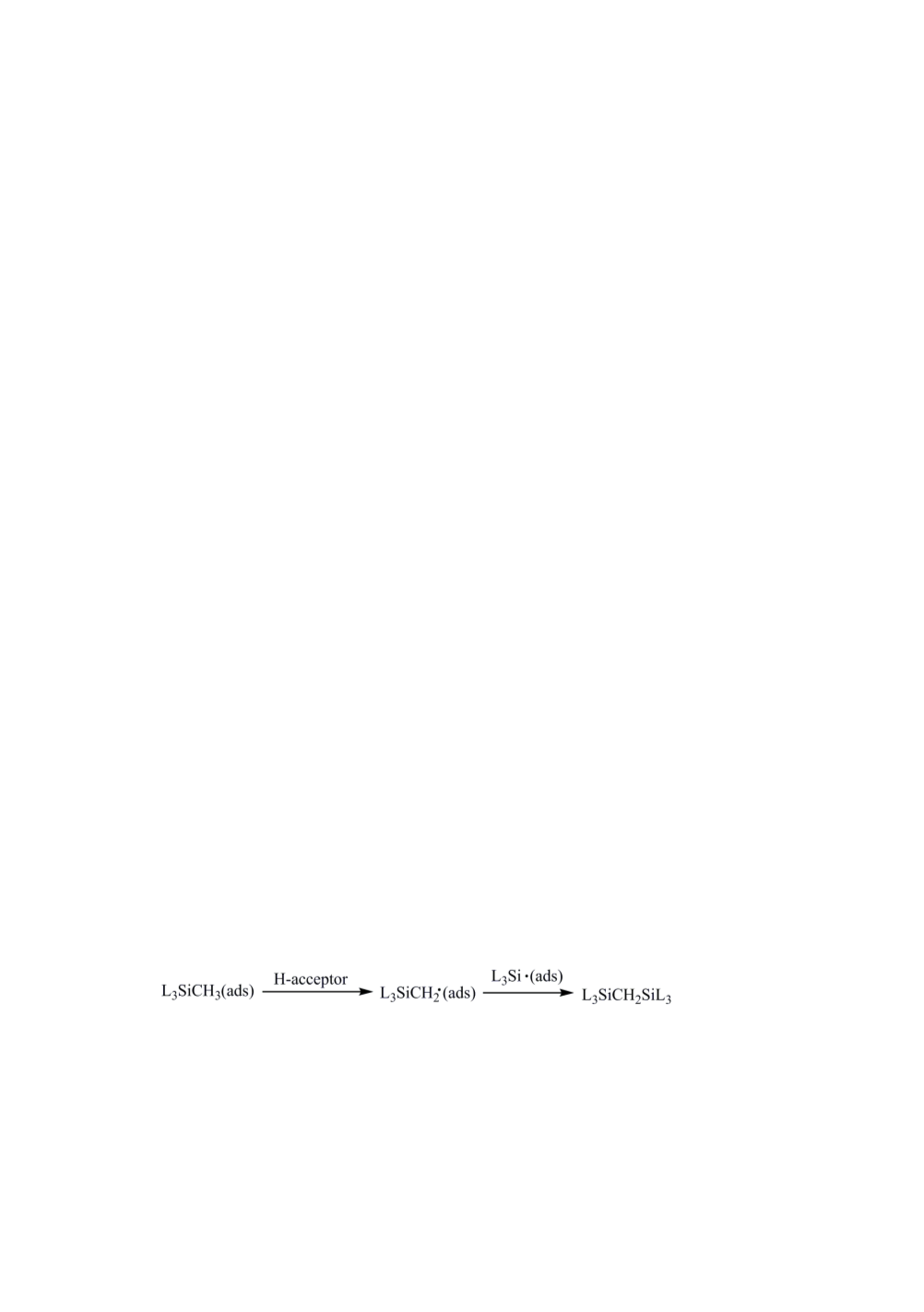

CH
3
Cl + 2 S ––> CH
3
(ads) + Cl(ads)
(1)
CH
3
(ads) + S
––>
CH
2
(ads) + H(ads)
(2)
CH
3
(ads) + H(ads)
––>
CH
4
(g) + 2 S
(3)
CH
2
(ads) + S
––>
CH(ads) + H(ads)
(4)
CH(ads) + S
––>
C(ads) + H(ads)
(5)
CH
2
(ads) + CH(ads) + C(ads)
––>
Coke + nH(ads)
(6)
Hydrogen, methane and other hydrocarbons with two to six carbon atoms are
commonly observed in the direct process.
11
Muller suggested that methane and
hydrogen were generated from reaction of two methyl radicals through reaction 7.
12
Alternately, methane can be generated from reaction of an adsorbed methyl group
with an adsorbed hydrogen through reaction 3. Chain growing for formation of other
hydrocarbons can occur in a reaction similar to 6.
2 CH
3
· ––> CH
4
+ H
2
+ C
(7)
Methyl chlorosilanes such as CH
3
SiHCl
2
(MeH) and (CH
3
)
2
SiHCl (Me2H) are formed
in the direct process. They are valuable for manufacturing of coupling agents and
other functional products.
1
The combined selectivity of these Si-H containing by-
products was found highly variable. Numbers in the range of around 1% to greater
than 50% have been reported.
1,13
It is reasonable to assume that the hydrogen ligands
originate from methyl chloride. However, there is no clear evidence of the direct
sources. Some possible sources include methyl groups, partially decomposed
fragments such as -CH
2
-, H
2
generated form reaction 7, or adsorbed hydrogen
generated from reactions 2 and 4.
In the direct process, there are by-products with the common L
3
Si-CH
2
-SiL
3
formula
(where L are ligands such as CH
3
-, Cl-, or H-). These by-products are collectively
named silmethylenes. They are part of the high-boiling by-products generally known
as direct process residue.
14
Silmethylenes were generated with higher yields in the
reaction of methylene chloride (CH
2
Cl
2
) and HCl mixture with silicon.
15
In that
reaction, the -CH
2
- group should be readily formed after cleavage of the two C-Cl
bonds in CH
2
Cl
2
. In the direct process with CH
3
Cl, the -CH
2
- must be generated from
a methyl group after cleavage of one C-H bond. However, the formation mechanism
of silmethylenes is not well understood. We speculate that the reaction mechanism
involves reaction of a surface methylene group with two silyl groups (8). The other
possible mechanism involves decomposition of the methyl group that is already on an
adsorbed MCS molecule to generate a Si-CH
2
- moiety, which combine with another
silyl group (9).
2 L
3
Si·(ads) + ·CH
2
·(ads) –––> L
3
Si-CH
2
-SiL
3
(8)
(9)
The side-reactions involving unproductive methyl groups can be summarized by
Scheme 1, at least from the mass balance standpoint. Scheme 1 shows that: (a) some
unproductive methyl groups are incorporated into methane and higher hydrocarbons
without going through C-H bond cleavage; (b) the remaining unproductive methyl
groups cleave different numbers of C-H bonds to generate hydrogen ligands and CH
x
(x = 0, 1, 2) fragments; (c) the hydrogen ligands are eventually incorporated into MCS
with Si-H bonds, hydrogen gas, or methane; (d) the CH
x
fragments are eventually
149


















